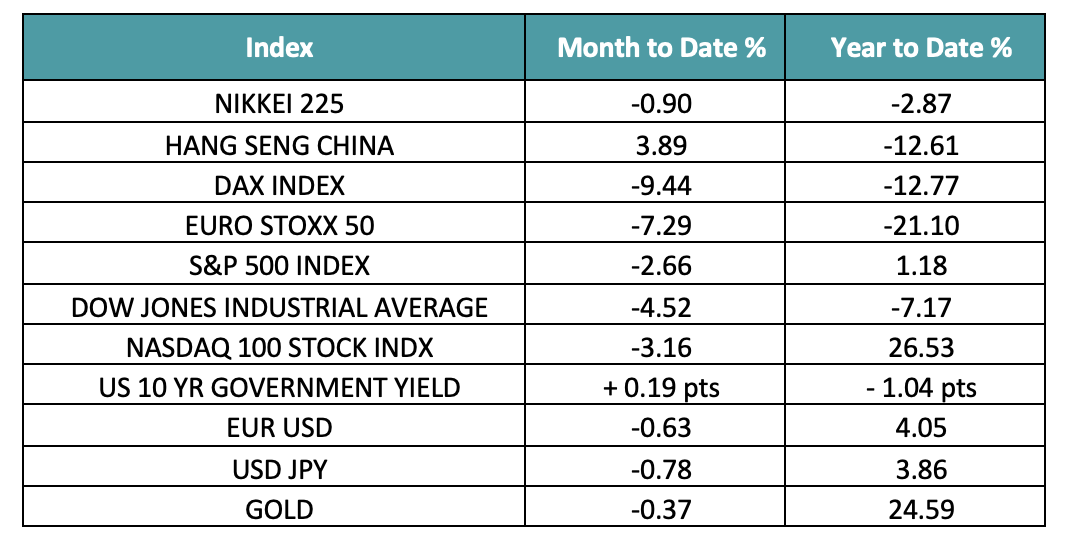October Monthly Review
A summary of key events and market trends during the month of October.
October saw a continuing of the narrow trading ranges across most asset markets
European indices were again the main underperformers, with the Eurostoxx index losing over 7% last month, mostly due to increased fears over the second wave of covid cases
It is now all about which way the chips fall as a result of the US elections
The continuing severity of the fresh wave of COVID-19 infections will lead to another lull in economic performance; the slack created will likely get offset with further central bank stimulus
US Election
Joe Biden leads Donald Trump by some 8 points in the national polling averages and by smaller, but still healthy, margins in the key swing states.
Will 2020 see a repeat of 2016 with a surprise victory for President Trump?
Key Markets

Key Trends
“Holding pattern” is probably what best describes the price action in the FX markets for the month of October; as well as for asset prices in general. The Dollar Index (DXY) appreciated all of two tenths of a percentage point while the Nasdaq did a bit of a round trip back to close to the highs of the year and closed down some three percent for the year.
We are now a day away from the action from the US elections and this promises to be interesting month based on how the results come through. President Trump continues to cast doubt on a potential loss and both sides are lawyering-up for what might just be a messy show-down. Whether the outcome finally is or isn’t contentious will primarily depend on the margin of victory.
The average US national poll shows Vice President Joe Biden leading by around 10 points. President Trump’s initial debate performance and subsequent coronavirus infection led to bump in VP Biden’s lead and that has held steady ever since. The third debate did not manage to dent that lead, nor did stories of Hunter Biden’s emails. Across the board, President Trump is seeing weaker support compared to his performance in 2016. Apart from the Presidential election the focus will be on the Senate and the million-dollar question of whether or not the Democrats manage to take control of that chamber. Polls here too indicate a strong showing by the Democrats and similar for the House elections.
Gaming a “Blue Wave” scenario is important from the perspective of understanding the make-up of the next Congress; a Presidency, House and Senate controlled by the Democrats has strong implications for the size of any stimulus package as well as suggesting the likely beneficiaries. Key elements of Candidate Biden’s proposals have been focused on a COVID-19 response, infrastructure and clean energy. The path of passage of these stimulus proposals should be easy in this scenario where the Democrats control Congress and the Presidency.
Other scenarios of a mixed Congress (the House very likely continues under Democratic leadership) leads to more muted stimulus responses and a different set of spending priorities.
As a final point, analogously and for some historical perspective, Ronald Reagan led Jimmy Carter by 47 to 44 points heading into the elections in 1980, went on to win 51 to 41 and in the process took 489 of the 538 electoral college votes. There has been some talk of a “Blue Wave” and now it’s time to leave the polls behind and wait for the results to flood in, or trickle in, depending on which state we are talking about.
While recent GDP data releases show economic growth bouncing back the recent strong spike in cases in Europe and the North America doesn’t bode well for economic activity going forward and the ECB has now signaled a desire to provide further support for the economy. The Federal Reserve meets Thursday and given the likely hit to the economy for the quarter might wish to signal similarly.
The sell-off in equity markets led to a resultant spike in equity volatility and the way this evolves will be driven by the political environment and the central bank response to any market nervousness.
At a broad level, valuations continue to be rich for companies delivering strong growth and profit margins, and attractive for companies that do not fall in that category. The value / growth conundrum, made more pronounced by the coronavirus, continues and striking the right balance of which companies to own and at what price drives a fair part of our discussions and resultant allocations.
Our longer-term views on the equity, fixed income and foreign exchange markets remain unchanged.
